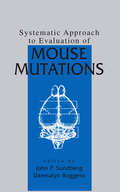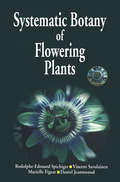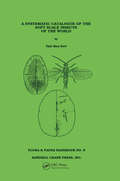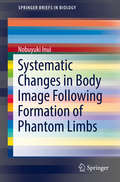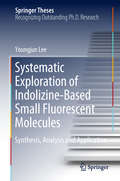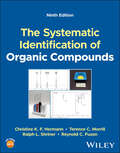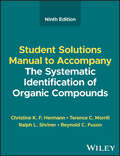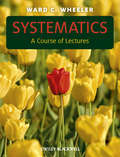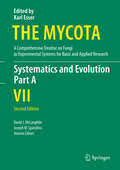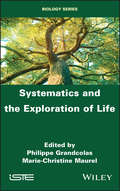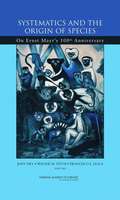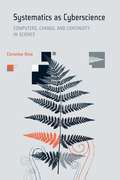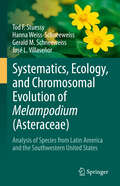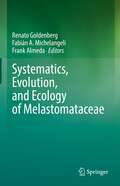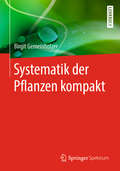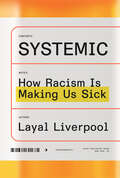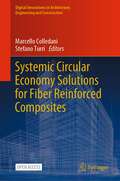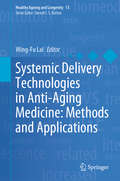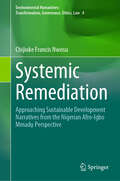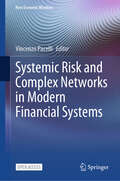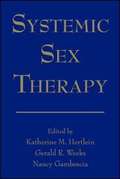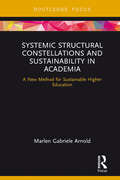- Table View
- List View
Systematic Approach to Evaluation of Mouse Mutations
by John P. Sundberg Dawnalyn BoggessExperts from The Jackson Laboratory and around the world provide practical advice on everything from how to establish a colony to where to go for specific mutations. The book includes information on medical photography, grafting procedures, and how to map the genes and evaluate the special biological characteristics of mice. It also discusses how to maintain a colony of mice that breed with difficulty, how to approach mapping spontaneous mutations, how to set up systems to evaluate a specific antibody, how to perform simple measurements that yield a large amount of information, and how to access mouse informatics on the Web.
Systematic Botany of Flowering Plants: A New Phytogenetic Approach of the Angiosperms of the Temperate and Tropical Regions
by R E. SpichigerThe principle objective of this book is to describe a range of families of flowering plants in a sequence corresponding to current phylogenetic classification based on the most recent results of molecular systematics. The selection of families is large and comprises families of temperate European flora as well as tropical flora. They are integrated in their respective orders and keys are given to help the reader recognize them. Each family is richly illustrated, the identifying characters being shown as clearly as possible. A glossary complements the overall didactic qualities of this reference.
Systematic Catalogue of the Soft Scale Insects of the World
by Yair Ben-DovA catalogue of the soft-scale insects of the world (Homoptera: Coccoidea: Cocidae) with data on geographical distribution, host plants, biology and economic importance. This catalogue lists 162 genera comprising 1090 species and subspecies which have been described since Linnaeus (1758) until the cutoff date of December 1991. Extensive data are presented on taxonomy, nomenclature, synonyms, geographical distribution, host plants, biology, and economic importance of the species. New combinations are established for 40 species. One species, namely Filippia subterranea Gomez-Menor Ortega, is newly synonymized with Lecanopsis formicarum Newstead.
Systematic Changes in Body Image Following Formation of Phantom Limbs
by Nobuyuki InuiThis book presents new findings on body image and also introduces new neuroscience-based methods for the fields of neurology and neurorehabilitation. Even when the hand is stationary we know its position - information that is needed by the brain to plan movements. If the sensory input from a limb is removed as the result of an accident, or as part of an experiment with local anesthesia, then a 'phantom' limb commonly develops. We used ischemic anesthesia of one limb to study the mechanisms that define this phenomenon. Surprisingly, if the fingers, wrist, elbow, ankle, and knee are extended before and during an ischemic block, then the perceived limb is flexed at the joint and vice versa. Furthermore, the limb is perceived to move continuously with no default position. The key parameter for these illusory changes in limb position is the difference in discharge rates between afferents in the flexor and extensor muscles at a joint. The final position of the phantom limb depends on its initial position, suggesting that a body image uses incoming proprioceptive information for determination of starting points and endpoints when generating movements. In addition, the change in position does not involve limb postures that are anatomically impossible, suggesting that illusory posture is constrained by body maps. These results provide new information about how the brain generates phantom limbs.
Systematic Exploration of Indolizine-Based Small Fluorescent Molecules: Synthesis, Analysis, And Application (Springer Theses)
by Youngjun LeeThis thesis describes an in-depth study of an indolizine-based fluorophore, from understanding of its structure-photophysical property relationship to its application as a useful biological reporter.Organic fluorophores have been extensively used in the field of molecular biology owing to their excellent photophysical property, suitable cell permeability, and synthetic flexibility. Understanding of the structure-photophysical property relationship of a given fluorophore often paves the road to the development of valuable molecular probes to visualize and transcribe biological networks. In this thesis, respective chapters deal with molecular design, organic synthesis, structure-property analysis, and quantum-mechanical interpretation of unexplored family of indolizine-based molecules. This systematic exploration has led to rational development of a new microalgae lipid droplet probe, colorful bioorthogonal fluorogenic probes, and a bright mitochondrial probe, working under live cell conditions.Harnessing the optical properties of a given fluorophore has been an important topic for a couple of decades, both in industry and in academia. This thesis provides useful insights for the improvement and development of unique small fluorescent materials, or optical materials.
The Systematic Identification of Organic Compounds
by Christine K. Hermann Terence C. Morrill Ralph L. Shriner Reynold C. FusonThe Systematic Identification of Organic Compounds A comprehensive introduction to the identification of unknown organic compounds Identifying unknown compounds is one of the most important parts of the study of chemistry. From basic characteristics such as melting and/or boiling point to more complex data generated through cutting-edge techniques, the range of possible methods for identifying unknown organic compounds is substantial. The utility of a research reference which compiles known techniques and characteristics of possible compounds is clear. The Systematic Identification of Organic Compounds provides such a reference, designed to teach a hands-on approach in the chemistry lab. It takes readers step-by-step through the process of identifying an unknown compound and elucidating its structure from infrared, nuclear magnetic resonance, and mass spectra in addition to solubility characteristics, melting point, boiling point, and classification tests. The result is an essential overview for advanced chemistry students looking to understand this exciting area of laboratory work. Readers of the ninth edition of The Systematic Identification of Organic Compounds will also find: A detailed chapter on safety, personal protection equipment, chemical storage, safety data sheets, and other safety concerns New NMR, IR, and mass spectra with detailed explanations on interpretation Questions at the end of each chapter designed to facilitate and reinforce progression, keyed to a companion website for instructors Tables of known compounds including data relevant for identification Companion website with structural problems from experimental data for students to practice how to reason and solve The Systematic Identification of Organic Compounds is a useful reference for advanced undergraduates and graduate students studying organic chemistry, organic spectroscopy, and related subjects.
The Systematic Identification of Organic Compounds, Student Solutions Manual
by Christine K. Hermann Terence C. Morrill Ralph L. Shriner Reynold C. FusonStudent Solutions Manual to Accompany
Systematics
by Ward C. WheelerSystematics: A Course of Lectures is designed for use in an advanced undergraduate or introductory graduate level course in systematics and is meant to present core systematic concepts and literature. The book covers topics such as the history of systematic thinking and fundamental concepts in the field including species concepts, homology, and hypothesis testing. Analytical methods are covered in detail with chapters devoted to sequence alignment, optimality criteria, and methods such as distance, parsimony, maximum likelihood and Bayesian approaches. Trees and tree searching, consensus and super-tree methods, support measures, and other relevant topics are each covered in their own sections.The work is not a bleeding-edge statement or in-depth review of the entirety of systematics, but covers the basics as broadly as could be handled in a one semester course. Most chapters are designed to be a single 1.5 hour class, with those on parsimony, likelihood, posterior probability, and tree searching two classes (2 x 1.5 hours).
Systematics and Evolution
by Joseph W. Spatafora David J. MclaughlinThis volume includes treatments of systematics and related topics for both fungi and fungus-like organisms in four eukaryotic supergroups, as well as specialized chapters on nomenclature, techniques and evolution. These organisms are of great interest to mycologists, plant pathologists and others, including those interested in the animal parasitic Microsporidia. Our knowledge of the systematics and evolution of fungi has made great strides since the first edition of this volume, largely driven by molecular phylogenetic analyses. Consensus among mycologists has led to a stable systematic treatment that has since become widely adopted and is incorporated into this second edition, along with a great deal of new information on evolution and ecology. The systematic chapters cover occurrence, distribution, economic importance, morphology and ultrastructure, development of taxonomic theory, classification, and maintenance and culture. Other chapters deal with nomenclatural changes necessitated by revisions of the International Code of Nomenclature for algae, fungi and plants, including the elimination of separate names for asexual states, as well as methods for preservation of cultures and specimens, character evolution and methods for ultrastructural study, the fungal fossil record, and the impact of whole genomes on fungal studies.
Systematics and the Exploration of Life
by Philippe Grandcolas Marie-Christine MaurelThis book's aim is to obtain and organize knowledge about the diversity of living things. Their epistomological and methodological fundamentals are explained in the framework of the biology of evolution. The methods of construction and use of phylogenetic trees are presented as well as the classification and description of taxa with the nomenclature rules.
SYSTEMATICS AND THE ORIGIN OF SPECIES: On Ernst Mayr's 100th Anniversary
by National Academy of Sciences of the National AcademiesIn December 2004, the National Academy of Sciences sponsored a colloquium on “Systematics and the Origin of Species” to celebrate Ernst Mayr’s 100th anniversary and to explore current knowledge concerning the origin of species. In 1942, Ernst Mayr, one of the twentieth century’s greatest scientists, published Systematics and the Origin of Species, a seminal book of the modern theory of evolution, where he advanced the significance of population variation in the understanding of evolutionary process and the origin of new species. Mayr formulated the transition from Linnaeus’s static species concept to the dynamic species concept of the modern theory of evolution and emphasized the species as a community of populations, the role of reproductive isolation, and the ecological interactions between species. In addition to a preceding essay by Edward O. Wilson, this book includes the 16 papers presented by distinguished evolutionists at the colloquium. The papers are organized into sections covering the origins of species barriers, the processes of species divergence, the nature of species, the meaning of “species,” and genomic approaches for understanding diversity and speciation.
Systematics as Cyberscience: Computers, Change, and Continuity in Science
by Christine HineAn exploration of the use of information and communication technologies by biologists working in systematics (taxonomy) and the dynamics of change and continuity with past practices in the development of systematics as a cyberscience.
The Systematics Association: The Systematics Association Special
by Peter D. Olson Joseph Hughes James A. Cotton Olson Peter D. Hughes Joseph Cotton James A.Cladistics is the method of choice for systematic classification and comparative studies in all fields of biology. In cladistics, reconstructed genealogies are based on common ancestry rather than on simple anatomical similarity and therefore effectively reveal true phylogenetic relationships. Now available in paperback, this excellent introduction to cladistics is based on the popular training course originally offered by the Systematics Association. The book surveys a wide range of topics, including the principle of parsimony, character coding and cladistic tree-building methods, tree statistics, and methods for determining character polarity. Alternatives to parsimony, molecular applications of cladistics, and the relevance of fossils are also discussed in detail. Concluding chapters review two critical topics of contemporary concern: cladistic biogeography and the implementation of cladistic results in systematics. In providing a readable, up-to-date account of modern cladistics techniques, the book will prove invaluable to all students and professionals interested in systematics and comparative studies.
The Systematics Association: The Future of Phylogenetic Systematics
by Williams, David and Schmitt, Michael and Wheeler, Quentin David Williams Michael Schmitt Quentin WheelerWilli Hennig (1913–76), founder of phylogenetic systematics, revolutionised our understanding of the relationships among species and their natural classification. An expert on Diptera and fossil insects, Hennig's ideas were applicable to all organisms. He wrote about the science of taxonomy or systematics, refining and promoting discussion of the precise meaning of the term 'relationship', the nature of systematic evidence, and how those matters impinge on a precise understanding of monophyly, paraphyly, and polyphyly. Hennig's contributions are relevant today and are a platform for the future. This book focuses on the intellectual aspects of Hennig's work and gives dimension to the future of the subject in relation to Hennig's foundational contributions to the field of phylogenetic systematics. Suitable for graduate students and academic researchers, this book will also appeal to philosophers and historians interested in the legacy of Willi Hennig.
Systematics, Ecology, and Chromosomal Evolution of Melampodium (Asteraceae): Analysis of Species from Latin America and the Southwestern United States
by Tod F. Stuessy Hanna Weiss-Schneeweiss Gerald M. Schneeweiss José L. VillaseñorChromosomal change has been important in the evolution of flowering plants. Cytogenetic modifications resulting in dysploid and polyploid alterations of plant genomes have often led to the formation of new species. A genus that represents an excellent example of such changes during its evolutionary history is Melampodium (Asteraceae), occurring primarily in Mexico, Central America, and the southwestern United States. This book is a detailed presentation of the diversity of species in Melampodium, their ecological requirements and phylogenetic relationships, the biogeographic patterns and migrational pathways, chromosomal diversity, and evolutionary origins of species, especially the tetraploids and hexaploids through allopolyploidy. It is an instructive case study of evolution through chromosomal change in a broadly distributed genus of importance in the ecosystems of Mexico and adjacent regions.
Systematics, Evolution, and Ecology of Melastomataceae
by Renato Goldenberg Fabián A. Michelangeli Frank AlmedaThis book presents a synthesis of critical new information for the Melastomataceae, one of the ten richest families among flowering plants with over 5,800 species that has its diversity highly concentrated in tropical or subtropical areas. It describes the family’s global diversity and distribution and summarizes recent advances in systematics, evolution, biogeography, reproductive biology and ecology.
Systematik der Pflanzen kompakt
by Birgit GemeinholzerDieses Kompakt-Lehrbuch vermittelt ein grundlegendes Verständnis für die Klassifizierung von Pflanzen und gibt Einblicke in den Artenreichtum der Pflanzenwelt. Es richtet sich an Bachelor- und Masterstudierende der verschiedensten Fachrichtungen. Die Autorin beschreibt hierzu die Pflanzensystematik auf dem aktuellsten Stand der Wissenschaft. Nach einer fundierten Einleitung zu den Grundlagen der Systematik, Taxonomie, Nomenklatur und Evolutionsforschung, lernt der Leser die einzelnen Pflanzengruppen und ihre Merkmale kennen. Das im Text vermittelte Fachwissen wird mithilfe von zahlreichen detaillierten Abbildungen veranschaulicht, was zu einem guten Verständnis des Buches und schnellem Lernerfolg beiträgt.
Systemic: How Racism Is Making Us Sick
by Layal LiverpoolIn the spirit of Medical Apartheid and Killing the Black Body; A science-based, data-driven, and global exploration of racial disparities in health care access by virologist, immunologist, and science journalist Layal Liverpool.Layal Liverpool spent years as a teen bouncing from doctor to doctor, each one failing to diagnose her dermatological complaint. Just when she&’d grown used to the idea that she had an extremely rare and untreatable skin condition, one dermatologist, after a quick exam, told her that she had a classic (and common) case of eczema and explained that it often appears differently on darker skin. Her experience stuck with her, making her wonder whether other medical conditions might be going undiagnosed in darker-skinned people and whether racism could, in fact, make people sick.The pandemic taught us that diseases like Covid disproportionately affect people of color. Here, Liverpool goes a step further to show that this disparity exists for all types of illness and that it is caused by racism. In Systemic, Liverpool shares her journey to show how racism, woven into our societies, as well as into the structures of medicine and science, is harmful to our health. Refuting the false belief that there are biological differences between races, Liverpool goes on to show that racism-related stress and trauma can however, lead to biological changes that make people of color more vulnerable to illness, debunking the myth of illness as the great equalizer.From the problem of racial bias in medicine where the default human subject is white, to the dangerous health consequences of systemic racism, from the physical and psychological effects of daily microaggressions to intergenerational trauma and data gaps, Liverpool reveals the fatal stereotypes that keep people of color undiagnosed, untreated, and unsafe, and tells us what we can do about it.
Systemic Circular Economy Solutions for Fiber Reinforced Composites (Digital Innovations in Architecture, Engineering and Construction)
by Marcello Colledani Stefano TurriThis open access book provides an overview of the work undertaken within the FiberEUse project, which developed solutions enhancing the profitability of composite recycling and reuse in value-added products, with a cross-sectorial approach. Glass and carbon fiber reinforced polymers, or composites, are increasingly used as structural materials in many manufacturing sectors like transport, constructions and energy due to their better lightweight and corrosion resistance compared to metals. However, composite recycling is still a challenge since no significant added value in the recycling and reprocessing of composites is demonstrated. FiberEUse developed innovative solutions and business models towards sustainable Circular Economy solutions for post-use composite-made products. Three strategies are presented, namely mechanical recycling of short fibers, thermal recycling of long fibers and modular car parts design for sustainable disassembly and remanufacturing. The validation of the FiberEUse approach within eight industrial demonstrators shows the potentials towards new Circular Economy value-chains for composite materials.
Systemic Delivery Technologies in Anti-Aging Medicine: Methods and Applications (Healthy Ageing and Longevity #13)
by Wing-Fu LaiThis book presents a multidisciplinary assessment of the state of science in the use of systemic delivery technologies to deliver anti-aging therapeutics now under development. There is a gap between basic aging research and the development of intervention technologies. This major obstacle must be overcome before biogerontological interventions can be put into clinical practice. As biogerontology comes to understand aging as a systemic degenerative process, it is clear that there is a pressing need for technologies that enable cells and tissues in a fully developed adult body to be manipulated systemically to combat aging. The authors review advances in the chemistry and engineering of systemic delivery methods and analyze the strengths and limitations of each.The book is organized into six sections. The first offers an overview of the need for systemic delivery technologies alongside the development of anti-aging therapies and describes approaches that will be required for studying the properties and efficiency of carriers for systemic delivery. Sections II, III and IV describe recent advances in a range of strategies that may enable systemic delivery to help combat aging conditions ranging from cell senescence to decline in immune function and hormonal secretion. Section V discusses practical strategies to engineer and optimize the performance of delivery technologies for applications in systemic delivery, along with their working principles. The final section discusses technical and biological barriers that must be overcome as systemic delivery technologies move from research laboratory to clinical applications aimed at tackling aging and age-associated diseases.Benefiting scholars, students and a broader audience of interested readers, the book includes helpful glossary sections in each chapter, as well as sidebars that highlight important notes, and questions for future research.
The Systemic Effects of Advanced Cancer: A Textbook on Cancer-Associated Cachexia
by Swarnali AcharyyaThis textbook discusses the systemic consequences of cancer, covering a range of topics from tumor-promoting systemic effects to the development of cachexia, as summarized in the introductory chapter 1. Part I of this textbook focuses on tumor-promoting systemic effects and begins with a chapter on how tumor-derived extracellular vesicles and particles lay the foundation for future metastases (Chapter 2). Chapter 3 discusses how metastatic cells that have colonized the bone impact the local bone microenvironment, neighboring muscles, and host physiology. Chapter 4 summarizes the available strategies for targeting metastatic cancer and emphasizes the need to incorporate a systemic view of the disease. Following this overview of the systemic effects of cancer progression, Part II of the textbook discusses cancer-induced cachexia, a debilitating systemic effect of advanced cancer. Chapters 5-7 examine the key signaling pathways (interleukin-6/GP130, NF-kB, and muscle proteolysis) that drive the development of cancer cachexia. Chapters 8 and 9 in Part III of this textbook explore how toxicities from anti-cancer therapy are associated with the onset of cachexia in cancer patients, and provide insight into potential approaches to simultaneously target both cancer and cachexia. Chapters 10 and 11 (Part IV) conclude this textbook by outlining promising approaches for the diagnosis and treatment of cachexia as well as strategies to prevent the development of cachexia through exercise. An understanding of the systemic effects of cancer is essential for the design of effective anti-cancer and anti-cachexia treatment strategies. As such, this textbook provides key information for both students and scientists engaged in cancer research and oncology.
Systemic Remediation: Approaching Sustainable Development Narratives from the Nigerian Afro-Igbo Mmadụ Perspective (Environmental Humanities: Transformation, Governance, Ethics, Law #4)
by Chijioke Francis NwosuSince the issues and discourses surrounding sustainable development entered its phase in our contemporary world, the political, social, economic, ecological, and cultural existence of our modern world has inevitably adopted varied measures to respond better to the demands of our time. This book contributes to the global call for transitions and transformations towards a more sustainable human society. This contribution is specific, dialogic and comparative and also has deep cultural and ethnological consciousness based on the Nigerian experiences and, by extension, the African experience. The research work presents as its background the hypothesis that varied forms of structures—socio-political, socio-economic, socio-ecological and socio-cultural—unite to constitute ‘structural sins’ (John Paul II) and, consequently, the banes to authentic and sustainable development. These dysfunctional structures were critically analysed and evaluated. Furthermore, the research work takes up the contemporary discourse on sustainable development, beginning with earlier development concepts, the impactful contribution of social documents of the church to development discourse, the timeline of the general global and sustainable development approach and governance, as well as the specifics of the twin documents of the year 2015, namely Agenda 2030 and Laudato Si. Again, an indigenised manuscript for development discourse known as Nigeria Vision 20:2020 was examined to delineate the fact that forms of indigenous efforts to discuss and administrate the development process are noticeable. However, such efforts have remained negatively exploited by both internal and external man-made corrupt factors. One such factors discussed in this book, among others, is the failure of Nigeria since independence to stabilise its power and energy sector.
Systemic Risk and Complex Networks in Modern Financial Systems (New Economic Windows)
by Vincenzo PacelliThis open access book is a groundbreaking exploration of systemic risk in modern financial systems. Through its theoretical and empirical investigations, it reveals the multidimensionality of systemic risk, the transmission channels of crises, and the interlinkages between physical, transition, and financial risks. It introduces cutting-edge methodologies, including prediction and optimization models based on complex networks, multilayer networks and eXplainable Artificial Intelligence (XAI) approaches, to forecast and measure systemic risk and financial crisis. It provides insight for academics, practitioners, policy and supervisory authorities, and bankers and financial market operators on understanding the links that determine the propagation of financial crises and the emergence of systemic risks. This book is essential for those wishing to better understand systemic risk and its implications.
Systemic Sex Therapy
by Katherine Milew Hertlein Gerald Weeks Nancy Gambescia Katherine M. Hertlein Gerald R. WeeksSystemic Sex Therapyserves as an introduction to the field of sex therapy from a systems perspective. It is an excellent resource for graduate students in marriage and family therapy programs or students and professionals who want a truly fresh perspective on sex therapy. This approach moves beyond traditional behavioral approaches to incorporate individual, couple, and intergenerational factors in etiology and treatment. Unlike current books on the market that are outdated, too advanced, simplistic, unfocused, or too diffuse in content, Systemic Sex Therapyis comprehensive, concise, highly focused on treatment, user-friendly, and contains features not found in other sex therapy texts, such as a systemic/behavioral focus, clinical innovation, and a greater focus on implementation rather than competing works.
Systemic Structural Constellations and Sustainability in Academia: A New Method for Sustainable Higher Education
by Marlen ArnoldIn order to create truly sustainable universities, we require new methods of visualising and interpreting them holistically as institutions built on complex relationships and systems, rather than as individual departments and people operating independently. This book uses a systemic structural constellations approach to demonstrate how we can build more sustainable higher education institutions, both in terms of teaching and research and at an operational level. Drawing examples from current research and teaching, Systemic Structural Constellations and Sustainability in Academia explores how universities are not only centres of teaching and learning but can also play a crucial role in enabling future decision-makers to appreciate and contribute to a more sustainable future. Providing a clear introduction to systemic structural constellations and guidance on how to practically apply the theory to numerous aspects of the higher education system, this book will be of great interest to students and researchers of education for sustainable development, organisational learning and sustainable management, as well as those tasked with transforming the higher education system for the future.
